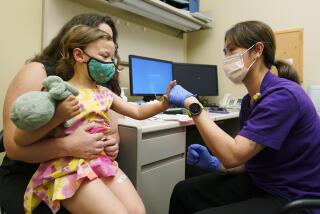Health Horizons : Speech Pathologists’ Goal: Improving Lives : They tackle communication disorders ranging from hoarseness and pronunciation problems to loss of speech from strokes or head injuries.
- Share via
When Colin began preschool last fall, his speech was unintelligible. When he wanted to communicate, he’d grab another child’s chin and yank at his face, or pull on his clothes and talk in a loud voice, speech and language pathologist Patti Wade recalls.
Wade, who works in the Beverly Hills School District, began giving Colin speech therapy. To improve his articulation, she showed him how to bite down gently on his lower lip and blow air out to make the “f” sound. She taught him a hand signal for “f” and several other sounds so she could cue him when he needed to use them. And she taught him play skills--for instance, how to get another child’s attention, and how to ask for a toy, rather than just grabbing it.
Today, Colin (not his real name) speaks in clearly articulated three- to five-word sentences. When he sees two other children talking, he asks, “Are you talking now? Do I have to wait?” He’s made good friends and visits with them after school.
“That’s the rewarding part of the job--to see a child make that much progress in such a short amount of time,” Wade says.
The feeling of making a difference in peoples’ lives is common for speech and language pathologists, who help children and adults overcome a wide range of communication disorders. These can be as simple as hoarseness or difficulty pronouncing r’s, or as serious as swallowing disorders or loss of speech from a stroke or head injury. Speech pathologists are also increasingly called upon to help reduce foreign accents.
Since the end of World War II, when clinics and research projects were set up to help veterans cope with speech defects from war injuries, the profession of speech and language pathology (popularly called speech therapy) has expanded rapidly.
Advances in research and technical knowledge have made speech therapy the rule rather than the exception in schools, hospitals and nursing homes, says Arlene Pietranton, director of the health services division of the American Speech-Language Hearing Assn., the Rockville, Md.-based professional, scientific and credentialing organization for speech-language pathologists and audiologists.
One such advance has been in the treatment of swallowing disorders, or dysphagia. The problem, frequently found among elderly people who have suffered strokes or who have cancer or Alzheimer’s disease, can lead to death from choking or from pneumonia after food enters the lungs.
To treat the disorders, speech pathologists, working with radiologists, use video fluoroscopy to X-ray the swallowing process and pinpoint the patient’s problem. While viewing the fluoroscopy, the pathologists determine which types of food and body positions best promote swallowing in a particular case. For example, they may see that a patient swallows best with warm, pureed food taken with the chin tucked down on the chest.
The development of effective diagnoses and treatments for swallowing disorders, combined with increased survival rates from strokes, head injuries and cancer, have fueled the booming demand for speech pathologists, says Louise Zingeser, director of the credentialing organization’s speech-language pathology branch.
Today there are more than 80,000 certified speech pathologists in the United States to serve the estimated 10% of Americans with communication disorders. More than 90% of speech pathologists are women, according to the American Speech-Language Hearing Assn. But although the ASHA certifies about 3,400 speech pathologists annually, that’s not enough to fill the available posts.
The scarcity has contributed to a small but steady rise in salaries, although they still remain modest. In 1994, the median salary for licensed speech-language pathologists with a master’s degree was $36,000; for those with a doctorate, it was $52,000.
Many speech pathologists work in hospitals, nursing homes, rehabilitation facilities and research laboratories, but more than half work in schools, where the pay mirrors teachers’ salaries.
A small but growing number of speech pathologists are in private practice, where they may earn as much as $100,000 a year. Managed-care reforms, however, are likely to squeeze incomes for private practitioners.
But even with these expected changes, speech pathologists will probably to remain in demand nationwide. In California, there are job openings all over the state.
“We have 1,000 school districts in California, and I would bet a quarter of them have unfilled positions,” says Robert Powell, director of government relations for the California Speech-Language Hearing Assn.
To become certified, speech and language pathologists must earn a master’s degree in speech-language pathology or an allied discipline, complete a 36-week clinical fellowship or its part-time equivalent, and pass a national examination. State licensing is also required, and speech pathologists in schools need teaching credentials. Increasingly, bilingualism and even trilingualism are helpful, as is multicultural expertise.
Speech and language pathologists employ a mixture of technical skills and psychological counseling. Janet Paulsen, speech-language pathologist for the Santa Monica-Malibu Unified School District, may observe during a home visit that a child who rarely talks in school is a chatterbox at home. So she’ll devise a therapeutic environment to help the child open up at school.
“It’s very rewarding to have a one-to-one or small group interaction with a child where . . . they can be creative and not worry about seeming silly to other people,” Paulsen says.
Helping children often requires thinking intensively about their particular problems and crafting individual solutions. “I come home emotionally spent,” she says, “but I never come home bored.”
Roberta Fields Poster, an Encino speech-language pathologist in private practice, spends part of every therapy hour helping parents with matters like choosing a school or helping their child make friends. Sometimes she can simply reassure parents that an excitable child who can’t yet communicate in words will soon do so.
On the other hand, Wade says, the hardest part of her job is telling parents their child is not developing normally.
“Very frequently, it’s the first time the parents have been told there’s something wrong,” she explains.
But even when they can’t totally fix a problem--as frequently happens, for example, with stuttering--speech pathologists help their clients view it with equanimity.
“We can intervene in a situation that might be negative in somebody’s life and help them discover how their life can be rewarding in spite of having such a disorder,” Paulsen says.
But along with the gratification of success comes the pressure of responsibility.
“These people are really depending on you,” Poster says. “You have to be at your best all the time. It’s hard.”
Adds Paulsen, “There are days when I come home and say, ‘I don’t know if I can do enough here.’ ”
Frequently, however, children and their parents will boost Paulsen’s spirits. She keeps a box full of thank-you notes from parents and kids. Some of Paulsen’s best referrals, she says, come from one child asking her to listen to another.
“There is a very special human connection with your clients,” she says, “and that can be tiring, but more often it’s exciting and energizing.”






